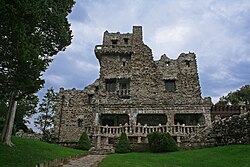Gillette Castle
|
Seventh Sister
|
|
 |
|
| Location | 67 River Rd., Hadlyme, Connecticut |
|---|---|
| Coordinates | 41°25′25″N 72°25′53″W / 41.42361°N 72.43139°WCoordinates: 41°25′25″N 72°25′53″W / 41.42361°N 72.43139°W |
| Area | 122 acres (49 ha) |
| Built | 1914 |
| Architect | Gillette, William; Porteus-Walker Co. |
| Architectural style | Bungalow/Craftsman, Medieval |
| Website | Gillette Castle State Park |
| NRHP Reference # | 86002103 |
| Added to NRHP | July 31, 1986 |
Gillette Castle State Park straddles the towns of East Haddam and Lyme, Connecticut in the United States, sitting high above the Connecticut River. The castle was originally a private residence commissioned and designed by William Gillette, an American actor who is most famous for his portrayal of Sherlock Holmes on stage.
The park is located at 67 River Road in East Haddam and consists of the castle (located in Lyme) and its grounds. It receives 300,000 annual visitors. It reopened in 2002 after four years of restoration costing 11 million dollars. It now includes a museum, hiking trails, and a picnic area.
William Gillette's "castle", called Seventh Sister, was built between 1914 and 1919 on a 184-acre (74 ha) tract at the top of the southernmost of a chain of hills known as the Seven Sisters. Gillette died having no children, and his will precluded the possession of his home by any "blithering sap-head who has no conception of where he is or with what surrounded". The State of Connecticut took over the property in 1943, renaming it Gillette Castle State Park. It was added to the National Register of Historic Places in 1986.
There are a number of oddities personally designed by Gillette, such as unusual doorknobs and locks, and a system of inconspicuous mirrors for surveillance of the public rooms from outside the master bedroom. One can see the Connecticut River from the castle's garden.
The grounds originally had a railroad that visitors could ride around the estate, complete with steam engine and an electric engine. The engines were later purchased by Lake Compounce in Bristol, Connecticut and were originally used to transport guests around the lake. The remaining track was pulled up and the roadbed converted into walking trails. The engines were donated to the park in 1992, and are now on display.
...
Wikipedia


